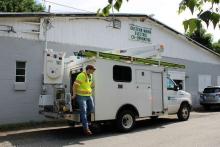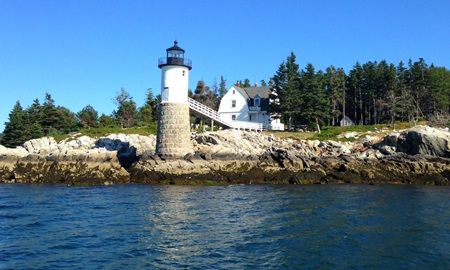
Peppered by winding country roads and remote islands, Maine exemplifies the challenges in even deployment of affordable broadband. But thanks to tenacious island communities and forward-thinking state leadership, a growing roster of community-owned broadband networks are leading the charge toward affordable access in the Pine Tree State.
Peggy Schaffer, former executive director of the state of Maine's broadband mapping and expansion effort, ConnectMaine, has played a starring role in shoring up Maine’s broadband mapping data after years of federal dysfunction.
Schaffer’s well versed in the broad array of challenges faced by remote Maine communities, and says she’s long been impressed by the “scrappy” nature of Maine’s community-owned island deployments, which have faced down and overcome no limit of onerous challenges in an ongoing quest to finally bridge the state’s long standing digital divide.
Maine is currently ranked 49th in the U.S. in terms of resident access to gigabit-capable broadband service. Like so much of the country, the state is heavily dominated by regional monopolies that failed to uniformly deliver affordable, next-generation broadband, despite decades of federal subsidies, regulatory favors, and tax breaks.
Now local Maine communities are taking matters into their own hands, beginning with long-neglected island residents no stranger to unique logistical challenges.

‘It’s A Story Of Perseverance’
In 2016, taxpayers on the island of Islesboro voted to approve a $3.8 million bond to help build an island-wide gigabit capable fiber network after years of being ignored by regional telecom giants. As a result, island residents now pay a $370 yearly subscriber fee for symmetrical gigabit access, dramatically less than many urban or suburban residents.
Schaffer said the success of the Islesboro project prompted similarly-neglected island towns, like Cranberry Isles Maine (population 160), to follow suit. Cranberry Isles’ $1.2 million fiber network was supposed to be heavily financed by a USDA Rural Development Community Connect Grant, but the grant didn’t arrive until the municipality’s build was nearly complete.
“I am not sure the town ever saw a USDA dime,” Schaffer said. “The redo of the paperwork was just too much for the community to deal with–along with their real jobs. They had taken out a tax-supported bond to pay for the network and stuck with that.”

Another Maine island, Isle au Haut, is also pursuing an island-wide fiber deployment on the back of an NTIA grant. That effort has required navigating not only the high costs and logistical headaches of island fiber deployment, but the seasonal and ecological challenges of undersea fiber runs off the frigid, tumultuous coast.
“The Army Corps of Engineers will only let them lay that cable from November to April because of worries of disturbing the natural fishing grounds,” Schaffer said. “Maine winters are not the best time to lay an undersea cable six miles through open ocean. Nevertheless, they are persisting.”
The Maine island community of Monheagan (population 119) is also getting close to lighting up an $800,000 volunteer-backed island-wide fiber network with the help of Axiom Technologies. Axiom’s involved in numerous Maine muni projects, as ISLR’s Christopher Mitchell discussed with Axiom CEO Mark Ouellette Episode 552 of the Community Broadband Bits Podcast.
Scaffer said Monheagan’s network, which will soon offer locals speeds of up to 200 megabit per second (Mbps) downstream at monthly or seasonal (yearly) rates, faced no limit of challenges related to USDA bureaucracy, tower citing issues, and a last-minute challenge by the local historic preservation society.

“The town and Island Institute finally convinced the historic preservation people that depopulation of the island without broadband was much more of a threat to the historical significance of the island than the tower,” Schaffer said. “I think they are going to light up this year. It’s a story of perseverance.”
From The Island To The Mainland
The scrappiness of Maine’s island community broadband efforts extends to the mainland, where numerous municipalities were incentivized, post-COVID, to explore faster and more affordable community-owned networks. But they too have faced no limit of challenges, many of which were manufactured by regional telecom giants staunchly opposed to added competition.
Regional cable giants like Charter are so frightened by the prospect, they’ve resorted to creating fake consumer groups designed to misinform locals, turning them against community owned and operated broadband networks. One such effort helped scuttle plans for a municipal broadband network in Southport Maine, which failed to get public approval by just 11 votes.
Despite incumbent monopolies’ best efforts, Schaffer says there’s now 22 publicly-owned broadband networks across the state of Maine, from the soon-to-launch municipal fiber network in Washington, Maine – to the Downeast Broadband Utility – the only municipal broadband utility in the state of Maine, jointly owned by Calais, Baileyville, Alexander, and Indian Township.
Somerville, Maine is also building a town-wide fiber network with a $1.4 million grant from the NTIA’s Broadband Infrastructure Program. That network should be completed and operational by this summer, providing locals the option of symmetrical 100 Mbps, 250 Mbps, and 500 Mbps service for $60, $65, and $110 a month, respectively.

However, the municipality has to contend with a lawsuit by Consolidated Communications in a test case for a state law that says municipally owned networks in unserved areas can attach to utility poles for free.
“Somerville is building now anyway – because of the federal shot clock on the money – and is not giving up on the lawsuit,” Schaffer says.
Big Opportunities, Big Challenges Ahead
Maine munis are poised to receive a portion of the state’s $272 million in broadband grant funding made possible by the Broadband Equity, Access, and Deployment (BEAD) Program and the 2021 infrastructure bill.
Maine was also recently the first state to have its digital equity plan accepted by the NTIA as part of its $2.75 billion Digital Equity Act program.
But here too Schaffer notes that Maine municipalities will face unique challenges that could be difficult to overcome, including numerous BEAD program restrictions that, when combined, could complicate municipalities’ attempts to obtain grant funding.
“This includes the ‘365 day shot clock’ that requires State Broadband Offices to identify all subgrantees within one year,” Schaffer said. “When combined with required scoring that heavily favors the highest match and how fast the project can be built, these are tough hurdles for small communities to overcome.”

Combined with eligible project areas that are not based on town boundaries – but instead based on locations unserved or without already committed funds (including RDOF and “planned builds” by the incumbent), munis may find themselves at a disadvantage in the race for funds.
Still, Maine’s growing municipal broadband ventures have demonstrated an unrelenting tenacity in bridging the digital divide, an attribute Schaffer says isn’t likely to wane.
“To me the story is about the obstacles that come with these projects–even when already funded–and how communities keep at it and keep at it because they are so committed to making sure their community members have access and because they understand the importance of public ownership of this asset,” Schaffer said.
“There is no finish line in this work.”
Header image of Downeast Broadband Utility worker and truck courtesy of Downeast Broadband Utility
Inline image of truck driving down road on Islesboro Maine courtesy of Bryan Bechtold, Attribution-NonCommercial-NoDerivs 2.0 Generic
Inline image of Lighthouse at Isle au Haut courtesy of JR P, Attribution-NonCommercial 2.0 Generic
Inline image of Downeast Broadband Utility network operations center courtesy of Downeast Broadband Utility
Inline image of ribbon cutting courtesy of Downeast Broadband Utility






